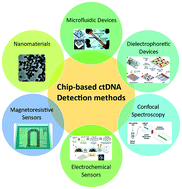Our official English website, www.x-mol.net, welcomes your
feedback! (Note: you will need to create a separate account there.)
Circulating tumor DNA and liquid biopsy: opportunities, challenges, and recent advances in detection technologies
Lab on a Chip ( IF 6.1 ) Pub Date : 2018-03-13 00:00:00 , DOI: 10.1039/c8lc00100f Lena Gorgannezhad 1, 2, 2, 3, 4 , Muhammad Umer 2, 3, 4 , Md. Nazmul Islam 1, 2, 2, 3, 4 , Nam-Trung Nguyen 2, 3, 4 , Muhammad J. A. Shiddiky 1, 2, 2, 3, 4
Lab on a Chip ( IF 6.1 ) Pub Date : 2018-03-13 00:00:00 , DOI: 10.1039/c8lc00100f Lena Gorgannezhad 1, 2, 2, 3, 4 , Muhammad Umer 2, 3, 4 , Md. Nazmul Islam 1, 2, 2, 3, 4 , Nam-Trung Nguyen 2, 3, 4 , Muhammad J. A. Shiddiky 1, 2, 2, 3, 4
Affiliation

|
Cell-free DNA (cfDNA) refers to short fragments of acellular nucleic acids detectable in almost all body fluids, including blood, and is involved in various physiological and pathological phenomena such as immunity, coagulation, aging, and cancer. In cancer patients, a fraction of hematogenous cfDNA originates from tumors, termed circulating tumor DNA (ctDNA), and may carry the same mutations and genetic alterations as those of a primary tumor. Thus, ctDNA potentially provides an opportunity for noninvasive assessment of cancer. Recent advances in ctDNA analysis methods will potentially lead to the development of a liquid biopsy tool for the diagnosis, prognosis, therapy response monitoring, and tracking the rise of new mutant sub-clones in cancer patients. Over the past few decades, cancer-specific mutations in ctDNA have been detected using a variety of untargeted methods such as digital karyotyping, personalized analysis of rearranged ends (PARE), whole-genome sequencing of ctDNA, and targeted approaches such as conventional and digital PCR-based methods and deep sequencing-based technologies. More recently, several chip-based electrochemical sensors have been developed for the analysis of ctDNA in patient samples. This paper aims to comprehensively review the diagnostic, prognostic, and predictive potential of ctDNA as a minimally invasive liquid biopsy for cancer patients. We also present an overview of current advances in the analytical sensitivity and accuracy of ctDNA analysis methods as well as biological and technical challenges, which need to be resolved for the integration of ctDNA analysis into routine clinical practice.
中文翻译:

循环肿瘤DNA和液体活检:检测技术的机遇,挑战和最新进展
无细胞DNA(cfDNA)是指几乎在所有体液(包括血液)中都可以检测到的无细胞核酸的短片段,并参与各种生理和病理现象,例如免疫,凝血,衰老和癌症。在癌症患者中,一小部分血源性cfDNA来源于肿瘤,称为循环肿瘤DNA(ctDNA),并且可能携带与原发性肿瘤相同的突变和遗传改变。因此,ctDNA可能为癌症的非侵入性评估提供机会。ctDNA分析方法的最新进展可能会导致液体活检工具的发展,该工具可用于诊断,预后,治疗反应监测以及追踪癌症患者中新突变亚克隆的兴起。在过去的几十年中,已经使用多种非靶向方法检测了ctDNA中的癌症特异性突变,例如数字核型分析,个性化的重排末端分析(PARE),ctDNA的全基因组测序以及靶向方法,例如基于常规和基于数字PCR的方法以及基于序列的技术。最近,已经开发了几种基于芯片的电化学传感器,用于分析患者样品中的ctDNA。本文旨在全面综述ctDNA作为癌症患者微创液体活检的诊断,预后和预测潜力。我们还概述了ctDNA分析方法的分析灵敏度和准确性以及生物学和技术挑战方面的最新进展,
更新日期:2018-03-13
中文翻译:

循环肿瘤DNA和液体活检:检测技术的机遇,挑战和最新进展
无细胞DNA(cfDNA)是指几乎在所有体液(包括血液)中都可以检测到的无细胞核酸的短片段,并参与各种生理和病理现象,例如免疫,凝血,衰老和癌症。在癌症患者中,一小部分血源性cfDNA来源于肿瘤,称为循环肿瘤DNA(ctDNA),并且可能携带与原发性肿瘤相同的突变和遗传改变。因此,ctDNA可能为癌症的非侵入性评估提供机会。ctDNA分析方法的最新进展可能会导致液体活检工具的发展,该工具可用于诊断,预后,治疗反应监测以及追踪癌症患者中新突变亚克隆的兴起。在过去的几十年中,已经使用多种非靶向方法检测了ctDNA中的癌症特异性突变,例如数字核型分析,个性化的重排末端分析(PARE),ctDNA的全基因组测序以及靶向方法,例如基于常规和基于数字PCR的方法以及基于序列的技术。最近,已经开发了几种基于芯片的电化学传感器,用于分析患者样品中的ctDNA。本文旨在全面综述ctDNA作为癌症患者微创液体活检的诊断,预后和预测潜力。我们还概述了ctDNA分析方法的分析灵敏度和准确性以及生物学和技术挑战方面的最新进展,











































 京公网安备 11010802027423号
京公网安备 11010802027423号